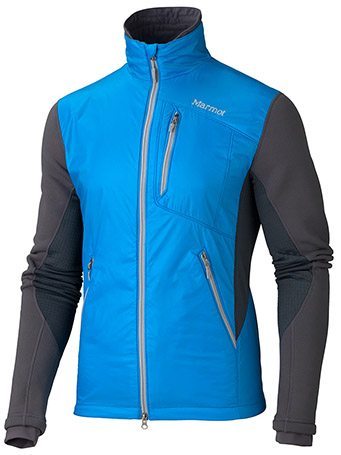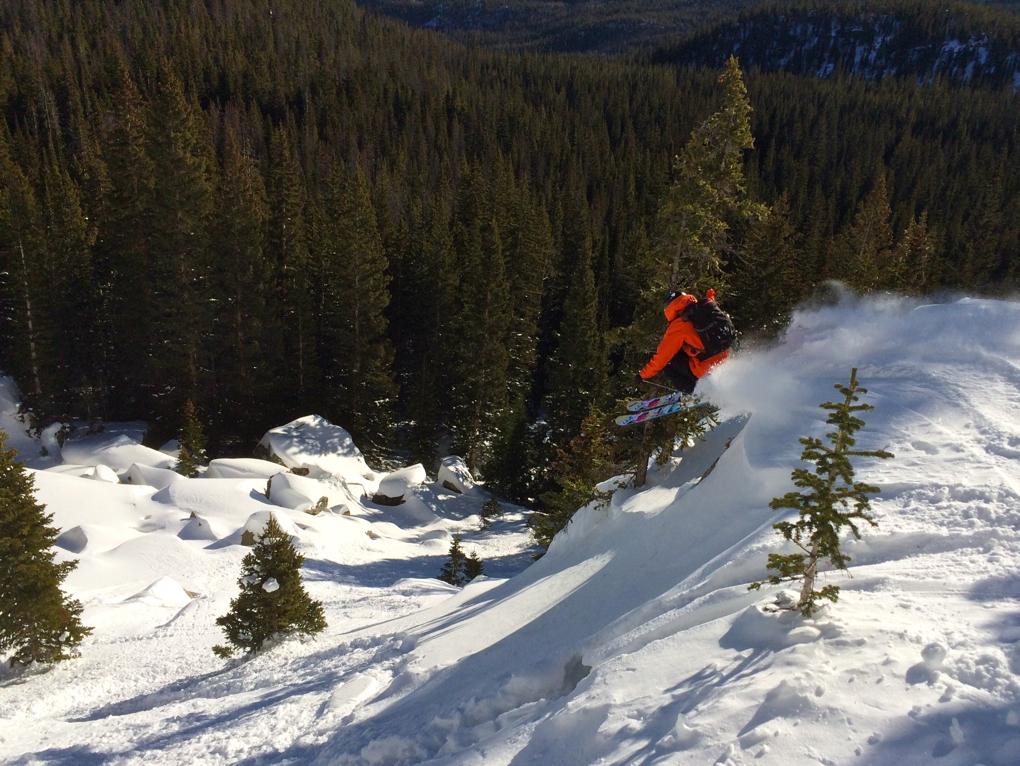
Marmot Alpha Pro
Size: Medium
Weight: 439.4 grams
Features:
• Polartec Alpha insulation
• Polartec Power Dry fleece
• 3 zip pockets (chest & two hand warmers)
• Pertex Quantum outer
Reviewer: 5’10”, 135 lbs
Days worn: 50+
Test Locations: Moab UT; Mosquito Range, Guanella Pass, Summit County, and Rocky Mountain National Park, CO
MSRP: $225 USD
[Editor’s Note: Reviewer Sam Shaheen has now tested the Alpha Pro for more than 50 days over the course of multiple seasons. As an update to our original post, he’s added a few new details to this review as part of a long-term assessment.]
The Marmot Alpha Pro was designed for high activity levels in cold, dry climates. And for that, it’s great.
But the first question this piece raises is, What is it?
A mid layer? (It does have puffy insulation.) An outer layer? (It does have a bunch of zip pockets and a DWR-treated shell.) Is it supposed to be worn as a base layer? (It does have a very slim and is practically skin tight throughout the forearms.)
The Alpha Pro is a bit of an enigma to the US wintersports market. Those who lean more toward the climbing side of things on the cold half of the year have probably seen a handful of these vest / fleece hybrid jackets, but for most of us, this type of jacket is pretty new. So let’s talk a bit about this jacket, because it’s actually quite cool.
Fabrics
The biggest story about the Alpha Pro (and the reason why we decided to review it in the first place) is the use of Polartec’s newest insulation: Alpha. Similar to the Polartec High Loft on The North Face Radium jacket I reviewed, Alpha works on the principle that lofted, low-density insulation is both warm and light. But Alpha is much more than just a high-loft, low- density insulation. Alpha is knit insulation.
If this doesn’t immediately seem all that revolutionary, what it allows manufactures to do is pretty sweet.
Traditionally, down and down analogs (i.e., most every synthetic insulation) require so called “down-proof” fabrics. Since down insulation has this knack for finding it’s way out of tiny holes in fabrics, these down-proof fabrics have super tight weaves with very fine thread to keep weight down. But these tight weaves of nylon do one thing very poorly: breathe.
By having a knit insulation, Polartec doesn’t have to worry about bits of the insulation sneaking out of the garment, because the insulation is a cohesive piece. This means that manufacturers can use much more breathable fabrics when designing for Alpha.
The Alpha Pro uses an extremely breathable mesh as a liner for the Alpha insulation. This means that the “puffy” parts of the jacket breathe more like a fleece than a standard puffy jacket. Pretty awesome.
Unfortunately, there are sections of the interior that are lined in Pertex as well (the same fabric used for the outer layer, a dense nylon weave that isn’t very breathable). It seems like Marmot chose the liner based mainly for durability. Areas that are likely to see a lot wear (like the shoulders) are lined with Pertex, while the rest of the body of the jacket is lined with mesh. On that note, after wearing the Alpha Pro for more than 50 days, I have no durability issues to report on either the ajcket exterior or its liner.
One question the Alpha Pro leaves unanswered is how does Alpha insulation work in the sleeves? Obviously this piece uses fleece for the sleeves, but on a lined garment, the sleeves are almost never lined in mesh because mesh is not as durable as nylon, and can be very grabby in the sleeves. I would be quite curious to see if a partial mesh lining is used on the sleeves of a full Alpha piece.
The sleeves on the Alpha Pro are a mix of two Polartec fabrics, Power Stretch and Power Dry High Efficiency. (Even though the product page from Marmot only shows standard Power Dry, the images appear to be the High Efficiency version of the fabric). Power Stretch is used on the majority of the sleeves and works as a good insulator. It is comfy with great range of motion due to the 4-way stretch.
The Power Dry High Efficiency is used from the underarm down to mid-way down the forearm. It does a great job of breathing and eliminating bulk. (FYI, this fabric is the same as Patagonia’s “Regulator” insulation from the R1 series. Polartec has always made the fabric for Patagonia, but had an exclusivity license up until a few years ago. This awesome fabric can now be found in insulators from multiple companies.)
Marmot uses many fabrics on this piece, and overall I think it works very well. The Alpha insulation is incorporated well and does a noticeably better job of breathing than traditional puffy jackets. The combination of fleece on the sleeves is quite comfortable while also optimizing breathability.
The next question is, How does all this fabric tech actually work?
Breathability
I have worn this jacket in a lot of conditions, from sunny, cold desert mornings to wet ski tours, and everything in between. This jacket is definitely at home in high output activities. It breathes great. I have only taken it off twice while wearing it, because I was getting too hot—once in Moab as the frigid morning gave way to a mild day high on the rock, and once in Rocky Mountain National Park on a very steep, 1500’ bootpack.

Overall, I give the breathability two thumbs way up. It doesn’t breathe quite as well as The North Face Radium, but it breathes better than every other insulator I own, including the Patagonia Nano Puff zip up, The North Face Thermoball and the MontBell Alpine Light parka. I would imagine the Alpha Pro is on par with the Patagonia Nano Air in this respect (if not a touch more breathable), though I haven’t had the chance to compare the two back-to-back.
Warmth
Another thing to note is that the Alpha Pro is really not that warm. It is warmer than a base layer, but it is definitely a step cooler than the Nano Puff/ Thermoball/Radium-category of warmth. I think it is a great weight for ski touring on the average day in Colorado, but if the temps dip into the teens or even single digits, I’d reach for The North Face Radium.


Hi,
Good review.
I’m 5’10” also but 180lbs by comparison and also wear a medium. My findings largely match up with
the review in terms of breathability but differ in terms of fit and mobility.
The forearms are tight on me but the bicep area is ridiculously loose and the sleeves are also
far too long. The fact that the forearms are tight means that I can disguise the superfluous
length by bunching the material up in that area.
I find the jacket doesn’t ride up at all when reaching over head, and I’ve used it exclusively
for Scottish winter climbing. I also have room to wear a long sleeve base layer and R1 style hoody (NW Alpine Black Spider Light Hoody in this case) under the Alpha Pro. I will note that due to the tight forearms and material choice it’s a bit of a struggle to get the Marmot piece on, but there is definitely room under it.
Bearing in mind that I’m almost 50lbs heavier than the reviewer but am wearing the same size,
perhaps the US cut is different to the European? I know this is the case in a few product lines
but usually the US cut is more, rather than less generous. We also can’t rule out copy to copy
variation: I may have got a medium that was over sized for instance.
All in all the jury is still out for me on this item, I think the main question I have is why use
breathable insulation and then over layer it in a fairly clammy material like Pertex? You
instantly lose the advantage that Alpha brings to the mix.
Rab seems to have got the point of using this new material by using a less windproof but more
breathable outer layer.
Hey Ronin,
Thanks for your comments!
One thing that I didn’t mention in the review is that the piece that I reviewed was a sample piece. It is quite possible that the cut got changed slightly before production, especially in the arm seams to improve range of motion.
And I certainly agree with your point on using Pertex as a shell layer on a supposedly super breathable insulation. However, I found that I really didn’t notice the Pertex hampering the breathability that much. My theory is that in periods of high activity, your sweat is building up within the insulation and on the outer Pertex layer, slowly breathing but not as fast as you sweat. During periods of low activity, the Pertex gets a chance to essentially catch up and get the rest of the moisture out of the jacket. As long as you don’t wet the majority of the the Alpha out, I’m not sure you’d notice outer Pertex as a vapor barrier.
This would be a great theory to test out using some other pieces, including the Rab line.
One important point is that I think we’ll see pieces using Alpha evolve significantly as manufactures figure out how they want to use the insulation.
Thanks again for your comments!
Sam
This review doesn’t feel complete to me. Is not Pertex Quantum a type of soft shell fabric that is supposed to have high weather resistance? You didn’t really talk about it’s water resistance in different weather conditions such as light rain, heavy mist, snow, and wind. I would assume that is the reason they used this fabric, instead of just ripstop nylon or something else…
Hey Alvin, thanks for your questions.
Pretax Quantum is a high density light weight weave that is designed to allow insulated garments to fully loft while keeping insulation in and rain/snow out. It is made with very low denier fibers that are woven very tightly. This is a very similar fabric to what is used in most high end “puffy” jackets.
For water and weather resistance, The Quantum on the Alpha Pro performs very similar to other DWR treated nylon insulators. Light snow dusts off just fine, especially in cold weather. Much more than a light flurry though, and I typically throw on a shell. To use this as an outer layer requires clear skies for the most part.
I wear this as an outer layer on pretty much all of my winter touring days on the way up unless it snows hard. Although the Quantum is essentially windproof, because the sleeves are not, I sometimes will put on a shell if winds get too high. On the way down, I always put a shell on.
I hope that clears everything up,
Sam
Ah..so it is no better than DWR treatment? In my experience, that is nearly worthless. I had read some stuff about Pertex that made it sound like so much more than that. I’m glad I got your response before spending any money on anything made of it.
I guess I can wait another couple of years until the next big thing comes out. Having already a closet full of insulating pieces, this climber surely doesn’t need to spend a couple of Benjamins on one weighing a pound and a half with cool-sounding technologies that don’t add anything.
Hey Alvin,
Pertex does have some cool technologies with variable denier weaves to promote breathability through capillary action, however, the shell fabric in this piece is pretty much just a DWR treated lightweight nylon face fabric. The cool thing about this piece is the Polartec Alpha insulation.